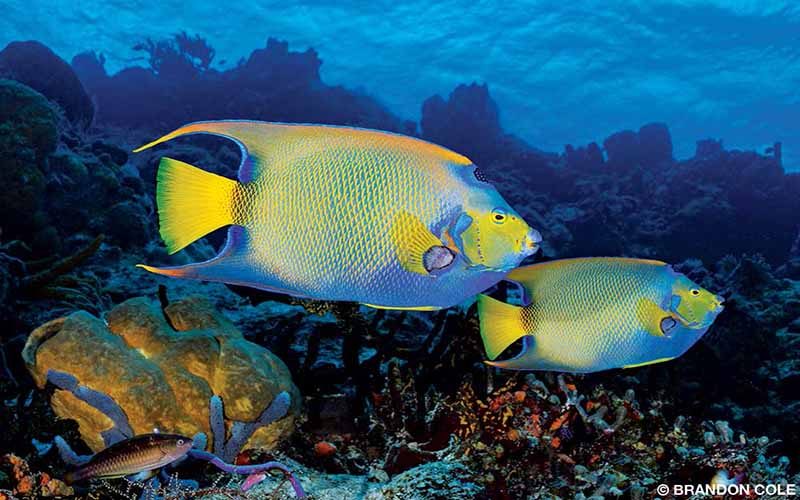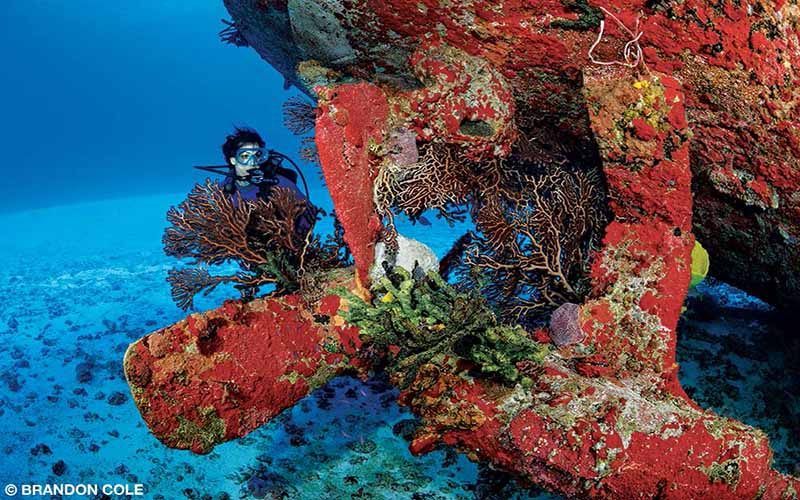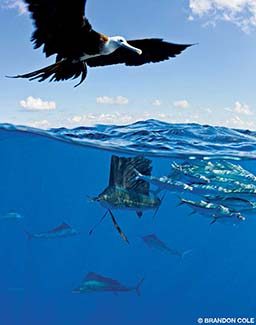Friends and colleagues reacted with surprise when I mentioned we were going back to Cozumel. Why redo Coz? Doesn’t the adage, “Been there, done that” apply?
Not at all. The reasons to return are many. This little sliver of an island east of Cancun is close to the U.S., its reefs are colorful and fishy, and a trip is quick and painless to organize. Unlike many expeditions to far-flung corners of the world, travel to Cozumel doesn’t require extensive and often frustrating logistical acrobatics. Additional impetus comes from the desire to create new images of this oft-photographed destination. Plus Cozumel is easily combined with other adventures, such as snorkeling with whale sharks in the summer and sailfish in the winter off nearby Isla Mujeres. With the snow piled high outside our home in the Pacific Northwest, why not escape south of the border and experience Coz again while drifting on warm currents down memory lane?
For our comeback tour, we begin where we last ended: We’re drawn to Paso de Cedral reef by our eagerness to immerse there once again. Rush hour is in full effect. There is a head-to-tail pileup of a hundred bluestriped grunts gracefully jammed together in the fast lane. We kick hard to hold position for a few shots of the streamlined school, and then we relax and are whisked away by the brisk current, which carries us alongside coral heads and shelving mini-walls bright with sponge gardens in bloom. A hawksbill sea turtle happily munches away on the colorful invertebrates, while a gray angelfish grazes on the fringe of algae growing on the reptile’s shell.

We duck into an alleyway bisecting the reef and turn a corner to encounter a huge grouper chilling in a cul-de-sac. The giant is easily 3 feet long and unfazed by our sudden appearance. Looking closely, I recognize it as a black grouper currently blanched white, likely advertising to the cleaning gobies in residence that it is safe to approach and perform their much-appreciated grooming services. A group of handsomely painted porkfish hovers behind, perhaps waiting their turn or just hanging in the protective presence of their larger cousin. Not wanting to overstay our welcome, we back out of the spa sanctuary and resume our nostalgic drift.
Thirty minutes later we excitedly confer back on the boat. Was this better than last time? We concur that today’s dive was at least as good and maybe better, which is saying something when gloom and doom reports on reef health and fish abundance are depressingly common in many parts of the world. Cedral was one of our favorite dives here 10 years ago and could very well be again on this trip. Our friend Hedrick gushes something about wanting to spend every day there for the rest of his life.
Superlative Structure

Knowing there is much more to see along the lee shore of this 30-mile-long island, we reposition and jump into a new section of blue, right over an immense shadow. Resting upright on the sand bottom about 80 feet below, the ARM General Felipe Xicoténcatl (C53) awaits our exploration. Commonly called just “the shipwreck” or “the Cozumel wreck,” the 184-foot-long vessel was originally named the USS Scuffle and served as a minesweeper in the U.S. Navy. It was later sold to the Mexican Navy for use as a patrol and support vessel. Finally, it was retired and given over to the sea when purposely sunk in June 2000 off the western side of Cozumel within easy striking distance of the city of San Miguel, where most of the dive fleet is based. The C53 has become a popular scuba attraction, drawing divers like metal to a magnet. We plummet down the descent line and make a beeline for the stern.

Festooned with red encrustations and green rope sponges, the ship’s twin propellers are an obvious photo stop. Hurricane Wilma’s wrath bent the port prop, so we set up on the photogenic starboard screw and get down to business. With my world narrowed to the camera’s viewfinder and my mind on metal and strobe angles, I happily lose myself in the picture-making process. I completely miss the spotted eagle ray that slowly swoops by just behind me. Ignorance is bliss, but wreck penetration is even better. Powering up LED torches, we sneak inside the C53 through a square cutout in the port stern corner and then wind through a series of chambers in the belly of the beast. Highlights of the dive include a territorial lobster valiantly guarding a hatch, the engine room and its mammoth machinery, levitating up a stairway and then slipping outside amidships into the afternoon light, and a detour lap around the bridge on our ascent. Before we are even out of the water, my wife, Melissa, and I have conferred and concurred: The wreck has definitely improved with time, with additional invertebrate growth, more critters hanging about and new compelling compositions to capture with the camera. Our wide smiles are proof that the know-it-alls saying there was no need to return to Coz again, that we had already seen all there was to see, had it all wrong.
One day we are spelunking through the innards of a shipwreck, the next we are delving into the reef itself. In the heart of Cozumel Reefs National Marine Park, Santa Rosa is an iconic site delivering a stunning experience up, down and through the middle of legendary real estate. Our guide, Alejandro, gives us a moment to reflect and be humbled as we gaze toward the surface from 120 feet, feeling so small while drifting along the imposing wall. He leads us into a sand chute that’s like a pristine ski slope glowing between glowering peaks. We angle up to traverse between thickets of sea fans and then squeeze through a narrow cut and enter a black tunnel snaking who knows where. Alejandro knows, for we eventually emerge into a chamber at 60 feet, an enchanted cave with ropey tangles of tangerine-colored sponges dripping from the ceiling. Three passageways radiate outward — skylights through which the blue beckons. We follow.
Cozumel Done Differently
That afternoon, following a tip from our deckhand, my wife and I and our four good friends and dive buddies embark on a mission to dine off the tourist grid. On our way we take the scenic route, strolling along San Miguel’s bustling boardwalk. Five floating cities masquerading as cruise ships dominate our seaward view. Some of their gazillion passengers certainly went diving today. Compared to these behemoths, the dozens of dive boats zipping up and down the coastline seem comically tiny. No doubt some of these vessels are coming from or going to the same sites we visited today. Cozumel has been a bastion of Caribbean diving for decades and has grown to become a very busy place, yet we had the friendly fishes and the reef fissures pretty much to ourselves today. Our good fortune was not accidental.

The six of us chartered a private six-pack boat with a crew willing to customize our experience. We choose the dive sites based on our target photo subjects, depth profile preferences, current strength, even the angle of sunlight. Each day we can tweak our departure time and the duration of our surface intervals, both of which are very helpful in staying clear of other bubble-blowing groups. We have no set depth or time limits; we can swim like hell or not move at all. Our born and bred Cozumeleno divemaster extraordinaire has a lifetime of bottom time on these very reefs. Everything has been strategized and optimized for maximum productivity and enjoyability. We dive, shoot and play like we want, all the while reaping the many benefits of working with a patient and accommodating local expert with a proven track record of delivering for experienced, discriminating divers and photographers. That, in summary, is our master plan. Hedrick sagely comments, “I’ve been diving in Cozumel more times than I can count, but never like this. There is no better way to dive.”
And there is no tastier food than the tacos al pastor we enjoy while seated on rickety plastic lawn chairs at a hole-in-the-wall restaurant a couple of miles from the glitzy main drag’s diamond shops, tourist mobs and Hard Rock Cafe. Simple and scrumptious, al pastor is a regional dish of marinated pork shaved thin, topped with a slice of pineapple and slathered in a chartreuse salsa verde, which practically ignites on its own. Cold cervezas and sugary horchata drinks pair perfectly with the tacos auténticos, and we feast like kings while enthusing over our dives so far and those yet to come.
Cornucopia of Critters
We start early before the fleet ventures forth and are the first to arrive at Chankanaab Reef. It is a new spot for me, and one sure to please according to our divemaster. He suggests we arm ourselves with a macro or zoom lens rather than a fisheye. It was sound advice, as we find a little bit of everything on the 10- to 20-foot-diameter coral heads strung together north to south. A group slideshow from this 75-minute dive to 55 feet would include images of everything from flamingo tongue snails on searods to a free-swimming green moray eel at least 6 feet in length. Artfully arranged clusters of vibrant purple rope and azure vase sponges would also be showcased along with another eagle ray that I once again did not personally see. While this seems to be a running joke on this trip, I can hardly grouse. With my versatile 17-70mm zoom lens, I acquitted myself admirably enough, capturing quality images of both a juvenile spotted drum pacing back and forth, its long streamer-like fins trailing elegantly, and a nurse shark. This guy (or gal — I forgot to peek) was absolutely bulletproof, allowing me to shoot tight, straight-on head shots, full-body profiles and wider-still “shark in its natural habitat” images, both with and without a person shown for scale. Adding icing on the cake to the photo session was the colorful sponge backdrop the shark so obligingly chose for its resting place.

A milelong drift in moderate current over San Juan Reef is also a first for us, introducing the lower-profile ridge reef structures characteristic of many sites north of town. Wrasses, loads of blue tangs and packs of snappers and grunts hunker close to the bottom, which is a shag carpet of various brown and green algae. Melissa later remarks that this spot reminds her of the Scottish moors with its gorse, heather and moss. Strangely shaped barrel sponges catch my eye. Unlike the classic, upright, tall urn shapes we are used to seeing, these are twisted, macaroni-like heaps or permanently leaning forms bent over in a northerly direction, shaped by the prevailing sea winds sweeping up the island.
Further offshore, more exposed to weather and known for very strong currents, Barracuda Reef was not diveable the last time we were here. Seas are manageable this trip, so we give it try, executing a negative entry with no fooling around on the way down. We level out at 80 feet to ride a cranking current, moving us ever northward. A river of schoolmaster snapper flows underneath us going the opposite direction. Longspine squirrelfish and banded cleaner shrimp shelter underneath mounds of orange elephant ear sponge. I tuck behind a buttress in the wall and find a heavily armored crustacean of surprising proportions, a channel clinging crab perhaps 2 feet across. We launch our surface marker buoys (SMBs) from 50 feet to show our position to our captain above. A tall SMB on a reel is a smart piece of gear for safely enjoying Cozumel.

Déjà Views
With our week winding down, I suggest we replay a few of the greatest hits from the previous decade. It is an easy sell to my friends, because who does not love the Coz classics? Down south at Columbia Deep, we retrace fondly remembered pathways in corridors lined with powdery white sand. We seek out shadowy crevices in which sprays of fiery red gorgonians light up the night. And I finally, miraculously, see and swim alongside a spotted eagle ray. Palancar Horseshoe wins for the most dramatic bottomography, which I first admire from above, framing a mind-bending circular fisheye photograph looking downward onto the ancient limestone labyrinth. I pay my respects to a turtle standing proud, imperiously surveying its coral kingdom from on high. But as always, I am drawn to the deep. I give myself up to gravity and sink into a dizzying network of crisscrossing avenues, stately arches and impressive vertical relief. Soaring coral spires are like skyscrapers. Visibility seems to stretch to infinity. From 20 fathoms (120 feet) down I can clearly see our boat, but I have no desire to ever ascend. This city beneath the sea is where I choose to live.

I will have to spend vacations, however, amid the riot of color and explosion of life at Tormentos Reef. Revisiting this mid-island site transports me back to the reef I previously logged as “a kaleidoscope through which fish fly.” Amorous filefish are still here, spinning about in courtship. Chummy pairs of queen angelfish continue to flaunt surreal hues in front of a palette of rainbowed sponges inspired by the impressionist masters. A honeycomb cowfish, whose paint job sparkles like opal, looks familiar. Cottonwicks, graysbys and yellow hinds remain tenants of Tormentos, sharing space with supersized lobster — irrefutable evidence that the national park’s protection is working. I am especially pleased to see a grumpy but most splendid toadfish. The entire menagerie is here and accounted for, and their future looks as bright as the reefscape.

Resplendence and revelry rolls on through our last day. We unanimously vote for more tacos magnificos at our secret spot, of course, but first we will celebrate for an hour or two with the masses of humanity. It is Carnaval, after all, and the streets of San Miguel are alive with music, dance and waves of happy people costumed as pirates, jaguars, dragons, fantastical plumed birds and even burlesque beauties. A little girl in mermaid finery stands atop a float adorned with swaying purple corals and pairs of angelfish. Another float features larger-than-life spotted stingrays. As we drift along on the warm currents of the smiling crowd, my thoughts carry me out to the blue and downward to the reefs below.
Been there, done that and cannot wait to do it all yet again.
Adventures on Isla Mujeres

Come for the scuba and the snorkeling. Before or after diving Cozumel, those in the know grab a snorkel and head to Isla Mujeres to add a spectacularly worthwhile extra dimension to their expedition. During summer months, dozens to hundreds of whale sharks come from afar to feed with abandon on rafts of fish eggs floating just below the surface. You will not see the tiny, transparent food, but it is impossible to miss, or ever forget, the sight of 15- to 30-foot-long sharks charging through the water column like freight trains, with their huge mouths open wide. Experts agree that there is currently no better place on the planet for reliable encounters with these gentle giants. The water clarity here is usually better than the world’s other whale shark hot spots, which is a major plus for photographers and videographers looking to create quality imagery.
For those visiting between January and March, a different phenomenon is on display: sailfish attacking schools of sardines. Sails are the fastest fish in the sea, so come prepared to swim and swim some more. Locating baitballs often entails spotting birds, so eagle-eyed captains of sport-fishing boats or smaller fiberglass pangas scan the skies to find the prize. When they say to go, jump without delay into the blue to witness magnificent pez vela (“fish sail” in the local lingo) flashing electric colors and fencing with rapier-like bills while working together with each other to first corral and then inhale the panicking sardines. For big-fish fans and adrenalin junkies, this glorious chaos is not to be missed. Be prepared to pay your dues: Rough conditions (winter weather can be challenging) and long days without much happening are to be expected between the bursts of frenetic action.

Isla Mujeres is easily reached via a short ferry ride from Cancun. It is a nice town, perhaps a bit more kicked back than Cozumel, with friendly people, great food, plenty of accommodation options and world-class pelagic marine megafauna encounters.
How to Dive It
Conditions: Cozumel is a year-round diving destination. Water temperatures range between 75°F and 85°F seasonally. Topside temperatures average 80°F. May to October is the rainy season, which often means afternoon showers. Water visibility is generally excellent, ranging between 75 and 150 feet, depending on the dive site. Current is almost always present and varies between gentle to strong. Carry a surface marker buoy, and follow your guide. Dive sites to the far north, far south and the frontier sites on the island’s rarely visited eastern windward side often experience rough seas and challenging conditions.
Diving logistics: There are dozens of land-based operators from which to choose. Most offer two-tank morning or afternoon trips. Some operators are affiliated with certain hotels. Many dedicated dive resorts have in-house scuba facilities. Families and groups of friends with similar interests and skill levels may wish to pursue private boat charters to optimize their diving experience.
Getting there: Some domestic carriers fly directly into Cozumel (CZM), and many airlines serve Cancun (CUN). If arriving at CUN, you will need transportation to the ferry terminal in Playa del Carmen and then passage by ferry to Cozumel.
| © Alert Diver — Q3 2018 |